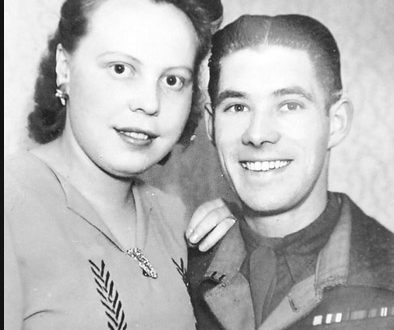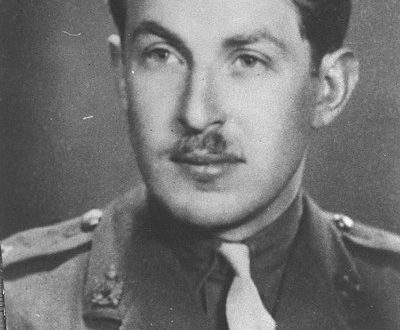History Learning Site Account
When Bergen-Belsen was handed over to British troops in April 1945, little could have prepared them for what they saw at the concentration camp. Belsen had originally been built as a prison for those arrested in Nazi Germany itself. However, as the war in Europe drew to a close in 1945, prisoners from Eastern Europe had been moved to the camp. When the British got to Belsen on April 15th, the prisoners were in appalling conditions and between 400 to 500 were dying each day.
 By April 1945, all the prisoners kept at Belsen were in real risk of catching typhoid or typhus. The German SS guards there were clearly in no position to stop this and there was a fear that once the prisoners were released and repatriated, they might spread the disease further a field. For this reason, the German authorities at the camp handed it over to the British on April 13th, and two days later120 British soldiers arrived at the camp led by Brigadier Glyn Hughes, Senior Medical Officer of the Royal Army Medical Corps. At the camp were 200 SS troops, 400 German guards and 4,000 Hungarian soldiers. The agreement made was that these men would stay at the camp to work but would have a guaranteed passage back to their own lines.
By April 1945, all the prisoners kept at Belsen were in real risk of catching typhoid or typhus. The German SS guards there were clearly in no position to stop this and there was a fear that once the prisoners were released and repatriated, they might spread the disease further a field. For this reason, the German authorities at the camp handed it over to the British on April 13th, and two days later120 British soldiers arrived at the camp led by Brigadier Glyn Hughes, Senior Medical Officer of the Royal Army Medical Corps. At the camp were 200 SS troops, 400 German guards and 4,000 Hungarian soldiers. The agreement made was that these men would stay at the camp to work but would have a guaranteed passage back to their own lines.
“I found a very great number of dazed, apathetic, human scarecrows, wandering around the camp in an aimless fashion, dressed in rags and some even without rags. There were piles of dead everywhere – right up to the front gate.”Colonel J Johnstone, RAMC
Hughes and his men found about 10,000 unburied bodies with another 40,000 inmates, many of whom were in a dreadful state. All official records relating to Belsen had been destroyed by the German guards on April 13th – on the orders of Berlin. Therefore, Hughes had no official figures to work on. The German/SS/Hungarians troops there were quickly put to use – burying the bodies, guarded by armed British soldiers with fixed bayonets to ensure that the work was done. Hughes was also mortified by the apparent complete lack of compassion he found amongst those who had guarded the inmates at Belsen. In particular, the camp doctor (theoretically in charge of the inmates health) seemed to exist in a state of ‘dumb insolence’ as Hughes later described it. Brigadier Hughes also estimated that about 1,000 of the living inmates died as a result of British soldiers giving them their rations – though it would have been difficult to tell if they had been killed by kindness or the ravages of disease. In his initial investigation, Hughes concluded that there had been no systematic atrocities at Belsen as had been witnesses at Auschwitz, but there was circumstantial evidence that some inmates might have been cremated before they were actually dead.
The main problems for Hughes and his men was to somehow control the disease risk at the camp and to sort out a fair food distribution scheme. There were far more inmates than 120 British troops could control so German troops were armed and ordered to assist. On the night of April 15th, inmates rioted over the limited potato ration given out. German troops opened fire and killed a number of them. Hughes then informed them that for every one inmate shot by a German/Hungarian soldier, he would execute one of them. There were no more incidents like this. But the equal distribution of food remained a problem as there were those inmates who were capable of getting food but getting food to those who were too ill to walk was a lot more problematic as the British troops had little idea where they were. Food could not be given out on trust to the healthier to hand over as it would simply have been eaten by them. The British eventually set up food-bins outside each hut. However, though enough food was being prepared for the inmates, there was no guarantee that everyone in each hut got their fair share.
On May 2nd, 1945, 95 senior medical students from London arrived at the camp. One, Michael Hargrave kept a diary of what he saw:
“We found Hut 224. We went into the hut and were almost knocked back by the smell. The sight that met us was shocking. There were no beds whatsoever and in this one room there were about 200 women, from 15 to 30 years old, lying on the floor. In some cases they wore few rags and in some cases they wore no clothes at all. The floor was covered in faeces and soaked in urine. They all had extremely severe diarrhoea and were too weak to move.”
The maintenance of hygiene was of paramount importance. When the British arrived at the camp, they found that there was no running water; there were toilets and showers but they did not work. Camp administrators claimed that this was the result of Allied bombing that had ruined local water supplies and led to sewage contaminating the water.
Another major problem the British faced was the obvious mental trauma that affected most inmates. So traumatised were some, that when they were offered better accommodation (though still within the confines of the camp because of the risk of disease spreading), they refused to leave the only thing they knew – their hut. Likewise, many refused to let go of the meagre possessions that they had despite being offered new ones – such as knives, plates etc.
Between April 15th and April 30th, all of the German troops disappeared. No records exist as to what happened but some inmates who survived claimed that many had been killed by the inmates. There were even stories that angry British soldiers also killed some of them. It is known that 10 German soldiers got typhus and were sent to a hospital within the camp. They were put in a ward with recovering inmates – it is not known what happened to them.
History Learning Site
10,796 total views



